Climate-Environmental Governance in the Mexico Valley Metropolitan Area: Assessing Local Institutional Capacities in the Face of Current and Future Urban Metabolic Dynamics
Abstract
1. Introduction
2. Current and Tendential Scenarios of the MVMA’s Urban Inflows and Outflows
3. ICI-CLIMA: Assessing Local Institutional Capacities for Climate-Environmental Action
4. Discussion: Implications of ICI-CLIMA 2019 Findings
4.1. Financial, Technological, and Human Institutional Capacity Building
4.2. Sustainable and Resilient Land Use Policies for Long-Term and Inclusive Urban Planning
4.3. Science-Policy Interface Enhancement and Knowledge Generation for Supporting a Participatory Urban Governance
4.4. Solving the Causes, Not Just the Symptoms, of Climate-Environmental and Other Types of Urban Vulnerability and Risks
5. Conclusions
Supplementary Materials
Funding
Institutional Review Board Statement
Informed Consent Statement
Data Availability Statement
Acknowledgments
Conflicts of Interest
Appendix A
- Aspect 1: Evaluates the existence and updating of climate-environmental planning instruments at the local level. A local Urban Development Program with no more than 3 years old is considered robust, while one up to 5-years old is pondered as sufficient. A 10-year-old program is evaluated as insufficient and a 15-year-old program or older as an obsolete. A local Risk Atlas is considered robust if it has been updated in a period of time no longer than 2 years, while a 3-to-5 year-old as one that is satisfactory. A local Risk Atlas 5 to 7 years old is appraised as insufficient and one older than 8 years as very limited. In evaluating both Urban Development Programs and Risk Atlas, government cycles have been considered, as well as the possibility of an additional renewal period for up to a total of 6 years as established by Mexican law (each cycle lasts 3 years for the case of local governments while at the state level a cycle lasts 6 years).For the case of local Climate Change Action Plans at the municipal level, ICI-CLIMA 1.0 only evaluates their existence, but in later versions, the index will assess their level of progress, which until 2019, for most the 14 existing programs in the MVMA, was unsatisfactory. Waste Management Plans at the local level are evaluated in the same way as local Climate Change Action Plans are in ICI-CLIMA 1.0.
- Aspect 2: The number of people in decision-making positions is assessed by coupling two components. On the one hand, the rate of human capacities for decision-making in each local government, measured in terms of the institutional potential to serve its population in climate-environmental related issues (number of officials per 100,000 inhabitants). On the other, the existing human capacity to cover the geographical extent of each demarcation (officials per square kilometer or hectares only when municipalities are too small). The rating scale for the first component assumes that a rate greater than 5 officials is a robust level, while between 3 and 4 is sufficient, between 1 and 2 insufficient, and less than 1 very limited. For the second case, it is presumed that a ratio of one official for less than 6.25% of the territory of each demarcation represents a robust situation, while between 6.26% and 12.5% is sufficient, between 12.6 and 25% insufficient, and more than 25% very limited. This last scale has the exception when it comes to very large territorial extensions with a relatively small population. In such cases, the aggregated valuation of the components is reduced by a quintile, which in turn derives from the aggregation of the highest values of the range obtained for each (which applies to all cases).In the case of the role and empowerment of women within local institutional structure and existing capacities on climate-environmental matters, the existence of 25% or less of women with respect to the total number of decision-making positions is considered a very limited level of empowerment. The presence of women in the range of 25.1% to 45% is considered as insufficient empowerment; 45.1% to 50% as sufficient, and equal to or greater than 50.1% as robust. Of course, any structure in which the role of women in decision-making positions is greater than 55% should also be considered as unbalanced, as it does not comply with a gender parity scheme. In later versions of ICI-CLIMA, the gender issue will be integrated with the capacities and training of decision-makers on climate-environmental issues.
- Aspect 3: Budgetary sufficiency is assessed through the analysis of the Annual Operational Programs of each demarcation, accounting for the weight of spending on climate-environmental matters. In order to avoid distortions in the measurement, programmed spending on urban infrastructure and equipment is not included, even if it has, to one degree or another, environmental implications (say on issues such as mobility or management of drinking water and sanitation services). Instead, it does include the budget for civil protection actions as it is central, not only for disaster prevention and management, but also to advance the local adaptation agenda. Given that local institutional capacities are being measured, this item does not contemplate spending executed from other levels of government. Considering that the proportion of spending on climate-environmental actions with respect to the total programmed spending of local governments does not in itself reflect the degree of sufficiency, a qualitative assessment is at the same time used. The later assessment is based on the perception of local decision-makers and the use of knowledge about local climate-environmental challenges. Both components are added considering equal weights.In relation to administrative efficacy and efficiency, the evaluation is only qualitative when dealing with governments just elected. Such evaluation is grounded on the appreciation of the decision makers themselves. When it comes to local governments on their last year in office, administrative efficacy and efficiency is assessed by reviewing both the programed budget and actual spending, but also thru the qualitative analysis described above. Aggregation gives the same weight to both components. ICI-CLIMA 1.0 for 2019 uses the first calculation.
- Aspect 4: Accountability on climate-environmental information is evaluated through a qualitative assessment on the degree of public accessibility to documents and not merely their existence. The extent to which local governments themselves are clear and direct in their dissemination is analyzed.Local authorities’ willingness to collaborate with ICI-CLIMA was valued in a comprehensive manner, including the request for appointments, openness during interviews, quality of the information or arguments offered, and the participation on the remaining process, including a qualitative exercise of self-assessment and the review of preliminary results of the ICI-CLIMA before its public release.
- Aspects 5, 6, 7, and 8: These three aspects are based on a qualitative evaluation derived from documentary and field work, the latter essentially based on interviews with local decision-makers on climate-environmental issues. It should be pointed out that the maximum value of evaluation, especially in aspect 7, is a level of sufficient capacities (noting robust capacities would mean that there is no longer room for improvement, in this case on social participation mechanisms).The weighting is equal for all of the various elements of ICI-CLIMA. For its aggregation, the highest level of each of the five scales has been used by ICI-CLIMA 1.0. Those elements whose valuation is unknown, have not been incorporated into the aggregation process, so that the results obtained can be comparable.While the quantitative components do not represent an appreciation challenge, but rather a simple verification process, the qualitative components do represent greater complexity. Therefore, in order to appreciate eventual differences, ICI-CLIMA index is ideally complemented by a self-assessment carried out by local climate-environmental authorities. Although this does not necessarily settle eventual differences, it does confirm transparency of the evaluation process. Details for each municipality can be consulted at: https://transformacionurbana.mx/en/projects/interface_sp/.
References
- SEDATU. Delimitación de las Zonas Metropolitanas de México 2015. Available online: www.gob.mx/conapo/documentos/delimitacion-de-las-zonas-metropolitanas-de-mexico-2015 (accessed on 24 November 2020).
- OECD. Estudios Territoriales de la OECD. Available online: www.gob.mx/cms/uploads/attachment/file/56213/valle-de-mexico-OCDE.pdf (accessed on 24 November 2020).
- Delgado Ramos, G.C. Real estate industry as an urban growth machine: A review of the political economy and political ecology of urban space production in Mexico City. Sustainability 2019, 11, 1980. [Google Scholar] [CrossRef]
- Pradilla Cobos, E. Zona Metropolitana del Valle de México: Una ciudad baja, dispersa, porosa y de poca densidad. In Pradilla Cobos, Emilio. In Ciudades Compactas, Dispersa, Fragmentadas; Porrua: Mexico City, Mexico, 2011; Chapter VIII; pp. 257–293. [Google Scholar]
- Calderon-Garcidueñas, L.; Kulesza, R.J.; Doty, R.L.; DÁngiulli, A.; Torres-Jardon, R. Megacities air pollution problems: Mexico City Metropolitan Area critical issues in the central nervous system pediatric impact. Environ. Res. 2015, 137, 157–169. [Google Scholar] [CrossRef] [PubMed]
- Delgado Ramos, G.C.; Mac Gregor Gaona, M.F.; Ortega León, R.; De Luca Zuria, A. Hacia una Agenda Coordinada de Acción Climática—Ambiental para la Zona Metropolitana del Valle de México; Plataforma de Conocimiento para la Transformación Urbana: Ciudad de México, Mexico, 2019. [Google Scholar]
- Graizbord, B.; Gonzalez Granillo, J.L. Urban Growth and Environmental Concerns: The Venture of the Greater Mexico City Metropolitan Area. Politics Policy 2019, 47, 178–206. [Google Scholar] [CrossRef]
- Lome-Hurtado, A.; Touza-Montero, J.; White, P.C.L. Environmental injustice in Mexico City: A Spatial Quantile Approach. Expo. Health 2020, 12, 265–269. [Google Scholar] [CrossRef]
- Lara Castañeda, E.A. Buen Vivir, Decrecimiento y Desarrollos Otros: Una Revisión y Propuesta Desde el Urbanismo y la Ciudad. Bachelor’s Thesis, Universidad Nacional Autónoma de México, Mexico City, Mexico, 2017. Available online: http://132.248.9.195/ptd2017/agosto/0764512/0764512.pdf (accessed on 24 November 2020).
- Delgado Ramos, G.C. Water and the political ecology of urban metabolism: The case of Mexico City. J. Political Ecol. 2015, 22, 98–114. [Google Scholar] [CrossRef]
- Kuhn, E.A. Metabolismo de um Municipio Brasileiro de Pequeño Porte: O caso de Feliz, RS. Ph.D. Thesis, Universidade Federal do Rio Grande do Sul, Porto Alegre, Brazil, 2014. Available online: https://lume.ufrgs.br/bitstream/handle/10183/96657/000918309.pdf?sequence=1&isAllowed=y (accessed on 24 November 2020).
- Díaz Álvarez, C.J. Metabolismo de la Ciudad de Bogotá, DC: Una Herramienta Para el Análisis de la Sostenibilidad Ambiental Urbana. Ph.D. Thesis, Instituto de Estudios Ambientales, Universidad Nacional de Colombia, Bogotá, Colombia, 2011. [Google Scholar]
- Díaz Álvarez, C.J. Bogotá: Entre el espejismo del crecimiento y la utopía del metabolismo sostenible. In Cuadernos de Utopía Colombia; Universidad Central: Bogota, Colombia, 2012. [Google Scholar]
- Inostroza Pino, L. Metabolismo urbano y apropiación de excedentes ecológicos. De la estepa a la arquitectura burguesa. Rev. Urbano 2013, 29, 34–44. [Google Scholar]
- García Serna, M.I.; Morales-Pinzón, T.; Guerrero Erazo, J. Análisis de flujos de agua en áreas metropolitanas desde la perspectiva del metabolismo urbano. Luna Azul 2014, 39, 234–249. [Google Scholar] [CrossRef]
- López-Tovar, M.A.; Gordillo-Martínez, A.J.; Cabrera-Cruz, R.B.E.; Otazo, E.M.; Prieto, F.; González, C.A.; Rolón, J.C. Tendencias de investigación y aplicación de metodologías del metabolismo urbano, para el sector de la construcción de vivienda. Rev. Iberoam. Cienc. 2019, 6, 1–14. [Google Scholar]
- Rivera León, G.J. Análisis de Flujos Dinámicos de Materiales Aplicado a la Proyección de Demanda de Materiales de Construcción en Colombia. Bachelor´s Thesis, Universidad Nacional de Colombia, Bogotá, Colombia, 2015. Available online: http://bdigital.unal.edu.co/51054/1/1017123336.2015.pdf (accessed on 24 November 2020).
- Quintero Ávalo, C.B.; Tabares Ramírez, A. Metabolismo Urbano en el Flujo de Materiales de Construcción de Vivienda de la Ciudad de Pereira. Bachelor’s Thesis, Universidad Tecnológica de Pereira, Pereira, Colombia, 2015. [Google Scholar]
- Herrera Mancero, J.A.; Vilema Tigxi, B.M. Análisis del Flujo Metabólico de los Materiales de Construcción en la Ciudad de Riobamba. Bachelor’s Thesis, Universidad Nacional de Chimborazo, Riobamba, Ecuador, 2019. Available online: http://dspace.unach.edu.ec/bitstream/51000/5900/1/UNACH-EC-ING-ARQT-2019-0007.pdf (accessed on 24 November 2020).
- Gómez-Azpeitia, G.; Arvizu Piña, V.; Arena Granados, P. Análisis del Ciclo de vida de la Vivienda de Interés Social en México. Available online: https://drive.google.com/file/d/1THzSZ1eIO1Ub58HQI0Y8kJFbZuBJdB_X/view?usp=sharing (accessed on 24 November 2020).
- Calderón, R.; Arredondo, J.A.; Gallegos, R.; Mayagoitia, F. Reducción del consumo eléctrico y CO2 mediante sistemas de ahorro y de aislamiento térmico aplicados a viviendas en zonas áridas de México. Inf. Tecnol. 2011, 22, 69–78. [Google Scholar] [CrossRef]
- Delgado Ramos, G.C. Metabolismo urbano y transporte. In Delgado Ramos, G.C. (coord). Transporte, Ciudad y Cambio Climático; CEIICH-UNAM: Mexico City, Mexico, 2012; pp. 129–168. [Google Scholar]
- Hackenhaar, I.C. Avaliação do Ciclo de Vida Para Apoiar Políticas Públicas Para o Desenvolvimento Urbano Sustentável: Um Estudo de Caso do Sistema de Transporte Público Coletivo de Porto Alegre. Master’s Thesis, Universidade Federal do Rio Grande so Sul, Porto Alegre, Brazil, 2020. Available online: https://lume.ufrgs.br/handle/10183/213543 (accessed on 24 November 2020).
- Páez, A. Energy-urban transition: The Mexican case. Energy Policy 2010, 38, 7226–7234. [Google Scholar] [CrossRef]
- Vergara Herrera, A.M. Una Aproximación del Consumo Energético a Través del Metabolismo Urbano. El caso de México de 1990–2015. Master’s Thesis, Instituto Politécnico Nacional, Mexico City, Mexico, 2018. Available online: https://tesis.ipn.mx/bitstream/handle/123456789/26072/Alejandra%20Mariel%20Vergara%20Herrera.pdf?sequence=1&isAllowed=y (accessed on 24 November 2020).
- Niño Soto, A.; Chávez Martínez, S. Metabolismo urbano: Reflexiones sobre el crecimiento urbano y el consumo energético. Rev. AUS 2020, 27, 80–85. [Google Scholar] [CrossRef]
- Delgado Ramos, G.C. El peso de las ciudades mexicanas en un contexto de cambio climático: Consumo de energía y materiales del Sistema Urbano Nacional. Plur. Consenso 2020, 46, 48–59. [Google Scholar]
- Guibrunet, L.; Sanzana Calvet, M.; Castán Broto, V. Flows, system boundaries and the politics of urban metabolism: Waste management in Mexico City and Santiago de Chile. Geoforum 2017, 85, 353–367. [Google Scholar] [CrossRef]
- Delgado-Ramos, G.C. Climate change and metabolic dynamics in Latin American major cities. In Sustainable City VIII. Urban. Regeneration and Sustainability; Zubir, S.S., Brebbia, C.A., Eds.; WIT Press: Southampton, UK, 2013; pp. 39–56. [Google Scholar]
- Delgado Ramos, G.C. Ecología política del metabolismo urbano y los retos para la conformación de ciudades de bajo carbono. Crítica Emancip. 2014, VI, 149–173. [Google Scholar]
- Barro Marín, M.G. Análisis del Metabolismo Urbano en la Ciudad de México y la Ciudad de Bogotá D.C. Bachelor’s Thesis, Universidad Autónoma del Estado de México, Toluca, Mexico, 2018. Available online: http://ri.uaemex.mx/bitstream/handle/20.500.11799/95335/UAEM-FaPUR-TESIS-MAR%c3%8dA%20GUADALUPE%20BARRO%20MAR%c3%8dN.pdf?sequence=1&isAllowed=y (accessed on 24 November 2020).
- Salazar, R.; Rojano, A.; López, I. Energy and environmental costs related to water supply in Mexico City. Water Supply 2012, 12, 768–772. [Google Scholar] [CrossRef]
- Delgado Ramos, G.C. Nezahualcóyotl, entre la segregación y los usos indeseables del suelo”. In Los Desafíos de la Ciudad del Siglo XX.; Álvarez Enríquez, L., Delgado Ramos, G.C., Leal Martínez, A., Eds.; Senado de la República/UNAM—CEIICH, PUEC, PUES: Mexico City, Mexico, 2016; pp. 363–396. Available online: https://drive.google.com/file/d/19w_YnNpD1JKYtlh23hUaU_9Ou5QgZcIS/view?usp=sharing (accessed on 24 November 2020).
- Delgado Ramos, G.C.; Blanco, H. La transformación de la infraestructura de agua ante el cambio climático: Los casos de Los Ángeles y la Ciudad de México. In Climate Change Sensitive Cities; PINCC, UNAM: Mexico City, Mexico, 2018; pp. 265–322. Available online: https://drive.google.com/file/d/1j6Bx40cw_CosLDuQM99H2VeVNbofa3J5/view (accessed on 24 November 2020).
- Guibrunet, L. The interplay of tacit and explicit knowledge in the informal economy: The atypical case of a recycling family business in Mexico City. Int. Dev. Plan. Rev. 2019, 2019, 1–19. [Google Scholar]
- Huerta-Barrientos, A. Scaling in Urban Complex Systems: Mexico City Metabolism. In Urban Agglomeration; Ergen, M., Ed.; Intech Open Science: London, UK, 2018; pp. 133–147. Available online: https://cdn.intechopen.com/pdfs/57499.pdf (accessed on 24 November 2020).
- Gómez Zamudio, R. Energy-Water Nexus in Mexico: A network Based Approach of Polycentric Governance. Master’s Thesis, Lund University Centre for Sustainability Studies, Lund, Sweden, 2019. Available online: http://lup.lub.lu.se/luur/download?func=downloadFile&recordOId=8978358&fileOId=8978362 (accessed on 24 November 2020).
- Rentería Juárez, P.M. Política Verde Urbana Ante el Cambio Climático: El caso de la Vivienda Sustentable en la Ciudad de México. Bachelor’s Thesis, Universidad Nacional Autónoma de México, Mexico City, Mexico, 2020. Available online: http://132.248.9.195/ptd2020/marzo/0801804/Index.html (accessed on 24 November 2020).
- Rojas-Ramírez, J.J. Periurbanización en zonas metropolitanas Guadalajara y Ocotlán, Jalisco. Bitácora 2019, 29. [Google Scholar] [CrossRef]
- McCulligh, C.; Vega Fregoso, G. Defiance from down river: Deflection and dispute in the urban-industrial metabolism of pollution in Guadalajara. Sustainability 2019, 11, 6294. [Google Scholar] [CrossRef]
- Luna Nemecio, J. El metabolismo urbano-rural del agua, actores sociales y gestión de los recursos hídricos público urbano de la ciudad de Cuautla, Morelos (2006–2013). Espac. Rev. Geogr. 2015, 5, 43–62. [Google Scholar] [CrossRef]
- Napoletano, B.M.; Paneque-Gálvez, J.; Méndez-Lemus, Y.; Vieyra, A. Geographic rift in the urban periphery, and its concrete manifestations in Morelia, Mexico. J. Latin Am. Geogr. 2019, 18, 38–64. [Google Scholar] [CrossRef]
- Benavides Mondragón, L.E. Advancing Sustainability in Latin American Cities: As Study Case of the Urban Metabolism of San Luis Potosí, México. Master’s Thesis, Universidad Autónoma de San Luis/Cologne University of Applied Sciences, San Luis Potosí, Mexico, 2017. Available online: https://ninive.uaslp.mx/xmlui/bitstream/handle/i/4337/MCA1BML201701.pdf?sequence=1&isAllowed=y (accessed on 24 November 2020).
- Cisneros Vidales, A.A. Building Sustainable Urban Metabolism through Resilience Strategies in La Pila, San Luis Potosí México. Master’s Thesis, Universidad Autónoma de San Luis/Cologne University of Applied Sciences, San Luis Potosí, Mexico, 2018. Available online: https://ninive.uaslp.mx/xmlui/bitstream/handle/i/4536/MCA1CVA201801.pdf?sequence=1&isAllowed=y (accessed on 24 November 2020).
- García Rodríguez, L.; Gracia, M.A.; Bello Baltazar, E.; Aldasoro Maya, E.M. Metabolismo social y ecoturismo: La problemática de los residuos en la isla de Holbox, Quintana Roo, México. Nova Sci. 2018, 10, 779–822. [Google Scholar] [CrossRef]
- IRP—PNUMA. The Weight of Cities. Resource Requirements of Future Urbanization; Swilling, M., Hajer, M., Baynes, T., Bergesen, J., Labbé, F., Musango, J.K., Ramaswami, A., Robinson, B., Salat, S., Suh, S., et al., Eds.; IRP—PNUMA: Nairobi, Kenya, 2018. [Google Scholar]
- Eurostat. Domestic material consumption. In Glossary; Eurostat b, 2016; Available online: http://ec.europa.eu/eurostat/statistics-explained/index.php/Category:Glossary (accessed on 24 November 2020).
- UNDESA. World Urbanization Prospects: The 2018 Revision; UNDESA: New York, NY, USA, 2019. [Google Scholar]
- OECD. Real GDP Long-Term Forecast-Mexico. Available online: https://data.oecd.org/gdp/real-gdp-long-term-forecast.htm (accessed on 24 November 2020).
- Mekonnen, M.M.; Hoekstra, A.Y. National Water Footprint Statistics. Statistics on Green, Blue and Grey Water Footprints of National Production and Consumption; Waterfootprint, 2012. Available online: https://waterfootprint.org/media/downloads/Report50-Appendix-VIII&IX.xls (accessed on 24 November 2020).
- Kaza, S.; Yao, L.; Bhada-Tata, P.; Van Woerden, F. What a Waste 2.0–Country Level Dataset; World Bank: Washington, DC, USA, 2018. [Google Scholar]
- World Bank. CO2 emissions (metric tons per capita). World Bank Data. Available online: https://data.worldbank.org/indicator/EN.ATM.CO2E.PC (accessed on 24 November 2020).
- FAO. The State of Food Security and Nutrition in the World; FAO; IFAD; UNICEF; WFP; WHO: Rome, Italy, 2020. [Google Scholar]
- CONEVAL. Medición de la Pobreza, Estados Unidos Mexicanos, 2010–2015. Available online: www.coneval.org.mx/Medicion/Documents/Pobreza_municipal/Concentrado_indicadores_de_pobreza.zip (accessed on 24 November 2020).
- UNHABITAT. The Value of Sustainable Urbanization; UNHABITAT: Nairobi, Kenya, 2020. [Google Scholar]
- Delgado Ramos, G.C.; Aragón Durand, F.; Di Bella, J.; Franco, C.; Henríquez Ruíz, C.; Hernández Pedraza, C. Urban and Rural Settlements. In Adaptation to Climate-Change Risks in Ibero-American Countries—RIOCCADAPT Report; Moreno, J.M., Laguna-Defior, C., Barros, V., Calvo Buendía, E., Marengo, J.A., Oswald Spring, U., Eds.; McGrawHill: Madrid, Spain, 2020; pp. 497–540. [Google Scholar]
- Khreis, H.; Sudmant, A.; Gouldson, A.; Nieuwenhuijsen, M. Transport Policy Measures for Climate Change as Drivers for Health in Cities. In Integrating Human Health into Urban and Transport Planning; Nieuwenhuijse, M., Khreis, H., Eds.; Springer: Berlin/Heidelberg, Germany, 2019; pp. 583–608. [Google Scholar]
- Liang, Y.; Du, M.; Wang, X.; Xu, X. Planning for urban life: A new approach of sustainable land use plan based on transit-oriented development. Eval. Program Plan. 2020, 80, 101811. [Google Scholar] [CrossRef] [PubMed]
- Zeller, V.; Towa, E.; Degrez, M.; Achten, W.M.J. Urban waste flows and their potential for a circular economy model at city-region level. Waste Manag. 2019, 83, 83–94. [Google Scholar] [CrossRef] [PubMed]
- Mohan, S.V.; Amulya, K.; Modestra, J.A. Urban Biocycles—Closing Metabolic Loops for Resilient and Regenerative Ecosystem: A perspective. Bioresour. Technol. 2020, 306, 123098. [Google Scholar]
- Bush, J.; Doyon, A. Building urban resilience with nature-based solutions: How can urban planning contribute? Cities 2019, 95, 102483. [Google Scholar] [CrossRef]
- Hunter, R.F.; Cleary, A.; Braubach, M. Environmental, health and equity effects of urban green space interventions. In Biodiversity and Health in the Face of Climate Change; Springer: Cham, Switzerland, 2019; pp. 381–409. [Google Scholar]
- Beatley, T. The emergence of biophilic design and planning Re-envisioning cities and city life. In Ecologies Design: Transforming Architecture, Landscape, and Urbanism; Zari, M.P., Connolly, P., Southcombe, M., Eds.; Routledge: New York, NY, USA, 2020; pp. 96–105. [Google Scholar]
- Ulbrich, P.; Albuquerque, J.P.; Coaffee, J. The Impact of urban Inequalities on Monitoring Progress towards the Sustainable Development Goals. Geo Inf. 2018, 8, 1–18. [Google Scholar]
- UNHABITAT. Habitat III Policy Paper: The Right to the City and Cities for All; United Nations: New York, NY, USA, 2017. [Google Scholar]
- Wolch, J.R.; Byrne, J.; Newell, J.P. Urban green space, public health and environmental justice: The challenge of making cities ‘just green enough’. Landsc. Urban Plan. 2014, 125, 234–244. [Google Scholar] [CrossRef]
- Deakin, M. The case for socially inclusive visioning in the community-based approach to sustainable urban regeneration. Sustain. Cities Soc. 2012, 3, 13–23. [Google Scholar] [CrossRef]
- Ahmad, E.; Dowling, D.; Chan, D.; Colenbrander, S.; Godfrey, N. Scaling up Investment for Sustainable Urban Infrastructure: A Guide to National and Subnational Reform; Coalition for Urban Transitions. 2019. Available online: https://newclimateeconomy.report/workingpapers/wp-content/uploads/sites/5/2019/04/CUT2019_Scaling_up_investment_for_sustainable_urban_infrastructure.pdf (accessed on 24 November 2020).
- WCRP—World Climate Research Programme. Global Research and Action Agenda on Cities and Climate Science; WCRP Publication No. 13/2019. 2019. Available online: https://www.wcrp-climate.org/WCRP-publications/2019/GRAA-Cities-and-Climate-Change-Science-Full.pdf (accessed on 24 November 2020).
- Su, C. Managed Participation: City Agencies and Micropolitics in Participatory Budgeting. Nonprofit Volunt. Sect. Q. 2018, 47. [Google Scholar] [CrossRef]
- Floater, G.; Dowling, D.; Chan, D.; Ulterino, M.; Braunstein, J.; McMinn, T.; Ahmad, E. Global Review of Finance for Sustainable Urban. Infrastructure; Coalition for Urban Transitions. 2017. Available online: http://newclimateeconomy.report/workingpapers/wp-content/uploads/sites/5/2018/01/NCE2017_CUT_GlobalReview_02012018.pdf (accessed on 24 November 2020).
- Shahzalal, M.; Hassan, A. Communicating Sustainability: Using Community Media to Influence Rural People’s Intention to Adopt Sustainable Behavior. Sustainability 2019, 11, 812. [Google Scholar] [CrossRef]
- Coskun, A.; Zimmerman, J.; Erbug, C. Promoting sustainability through behavior change: A review. Des. Stud. 2015, 41 Pt B, 183–204. [Google Scholar] [CrossRef]
- Delgado Ramos, G.C.; Mac Gregor Gaona, M.F. Índice de Capacidades Institucionales Climáticas–Ambientales Locales ICI-CLIMA 2019: El caso de la Zona Metropolitana del Valle de México; Plataforma de Conocimiento para la Transformación Urbana-IDRC-INGSA: Mexico City, Mexico, 2020; p. 47. Available online: https://zenodo.org/record/3984235/files/ICI-CLIMA%202019.pdf?download=1 (accessed on 24 November 2020).
- INECC. Medición Multidimensional de Capacidad Institucional a Nivel Municipal que Fomente la Adaptación al Cambio Climático; INECC-SEMARNAT: Mexico City, Mexico, 2017; ISBN 9781636256634. [Google Scholar]
- Mac Gregor Gaona, M.F. Caja de Herramientas para Medir la Vulnerabilidad y el Riesgo Urbano ante el Cambio Climático: El caso de la Ciudad de México; Technical Report—Master on Sustainability Sciences; UNAM: Mexico City, Mexico, 2020. [Google Scholar]
- Municipality of Oslo. Climate Budget 2019. Available online: https://www.klimaoslo.no/wp-content/uploads/sites/88/2019/03/Climate-Budget-2019.pdf (accessed on 24 November 2020).
- New York City Council. New York Participatory Budgeting. Available online: http://ideas.pbnyc.org/page/about (accessed on 24 November 2020).
- Jiménez, G. Caen dos funcionarios vinculados al narco en Cuajimalpa. Excelsior. 10 October 2020. Available online: https://www.excelsior.com.mx/comunidad/caen-dos-funcionarios-vinculados-al-narco-en-cuajimalpa/1410442 (accessed on 24 November 2020).
- Pelling, M.; Garschagen, M. Put equity first in climate adaptation. Nature 2019, 569, 327–329. [Google Scholar] [CrossRef] [PubMed]
- Tollefson, J. How the coronavirus pandemic slashed carbon emissions. Nature 2020, 582, 158–159. [Google Scholar] [CrossRef] [PubMed]
- Delgado Ramos, G.C.; López García, D. Las Ciudades ante el COVID-19: Nuevas Direcciones para la Investigación Urbana y las Políticas Públicas; Plataforma de Conocimiento para la Transformación Urbana: Mexico City, Mexico, 2020; Available online: https://zenodo.org/record/3894075/files/Ciudades%20ante%20el%20COVID-19.pdf?download=1 (accessed on 24 November 2020).
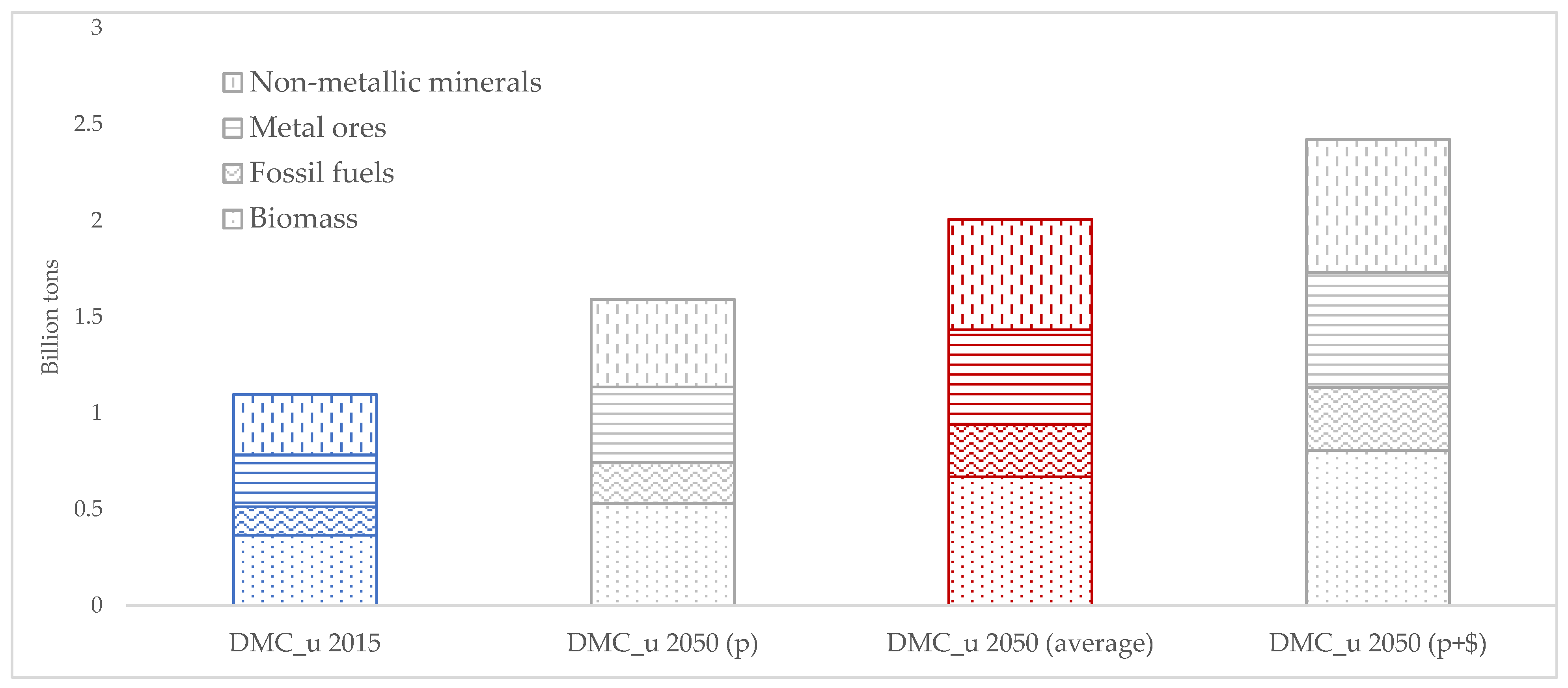
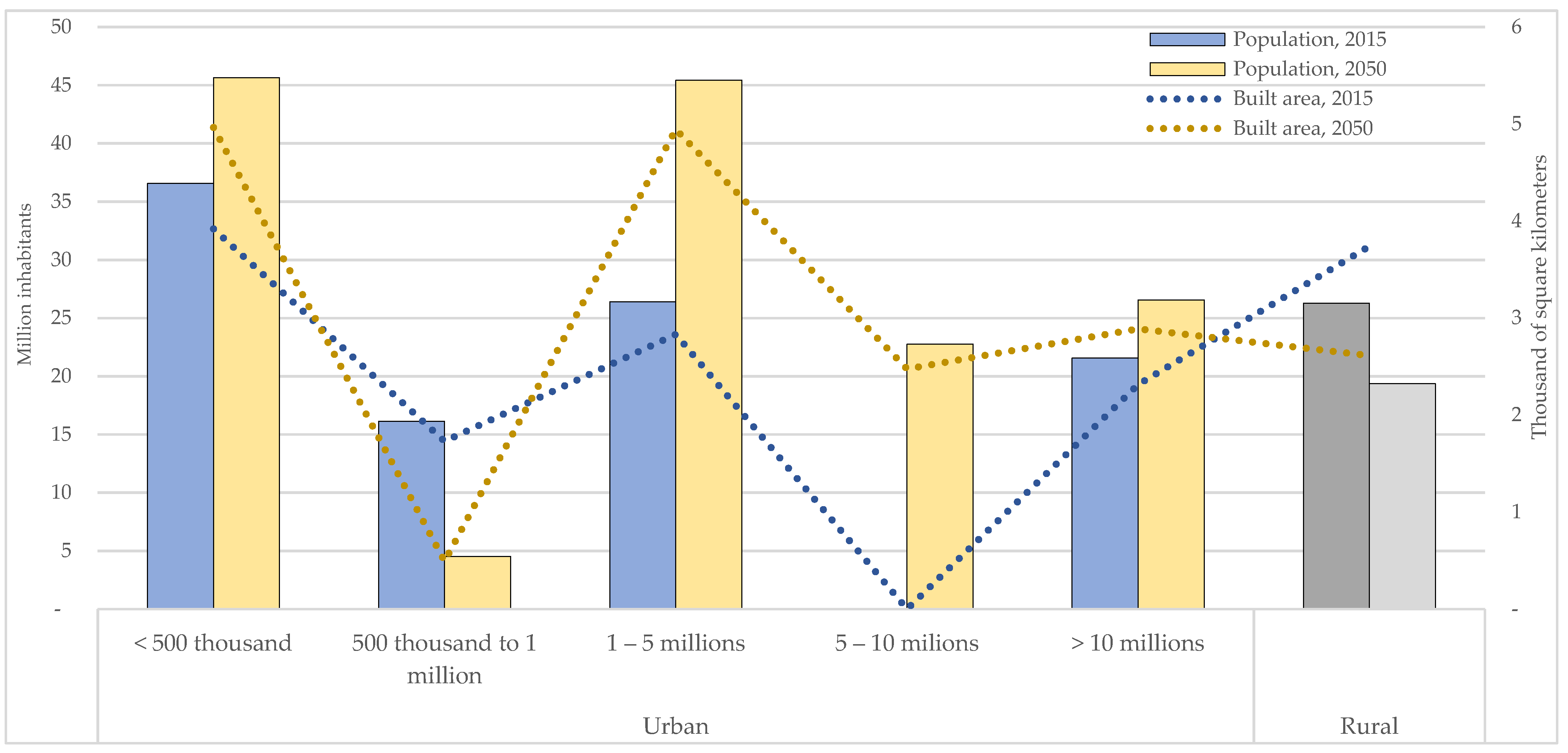
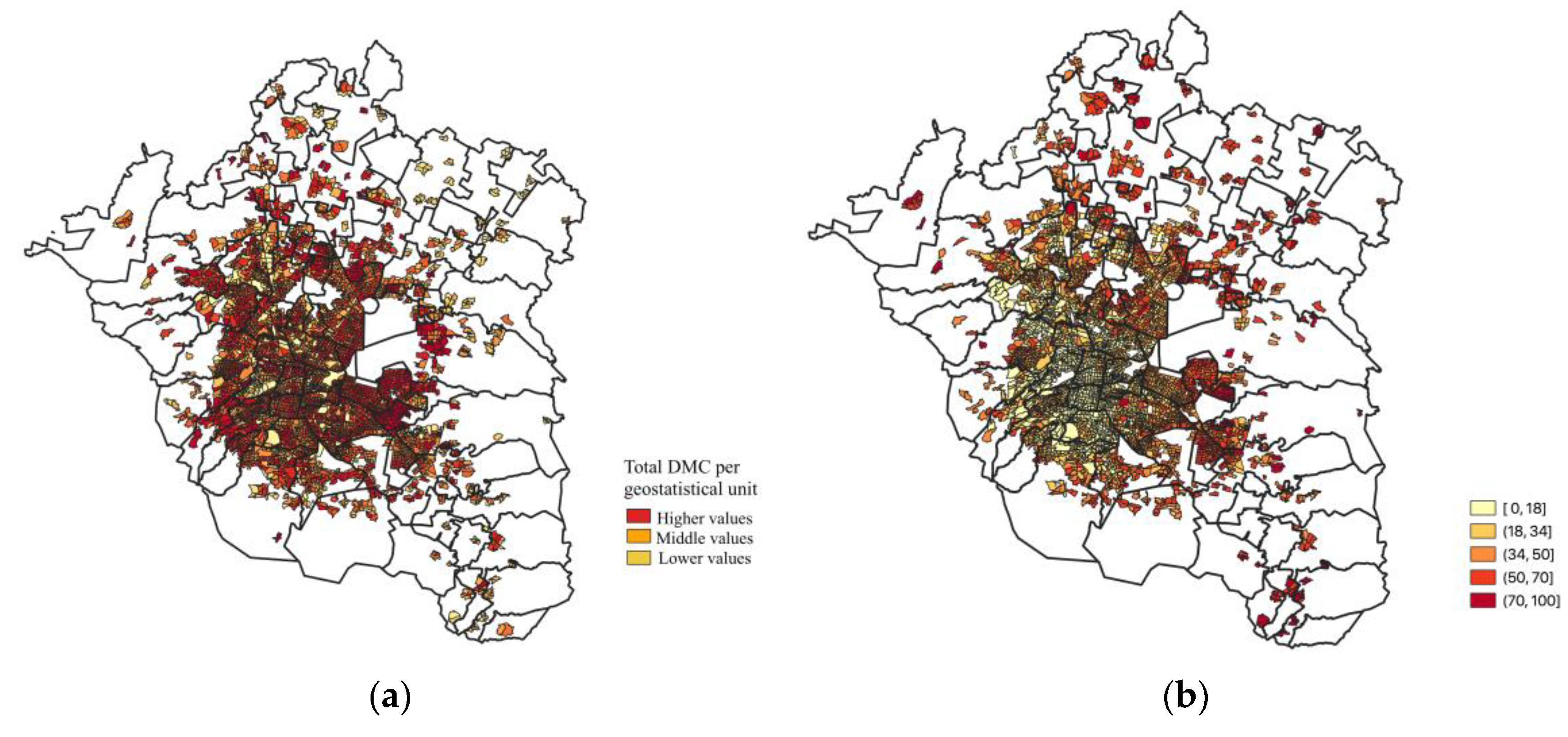
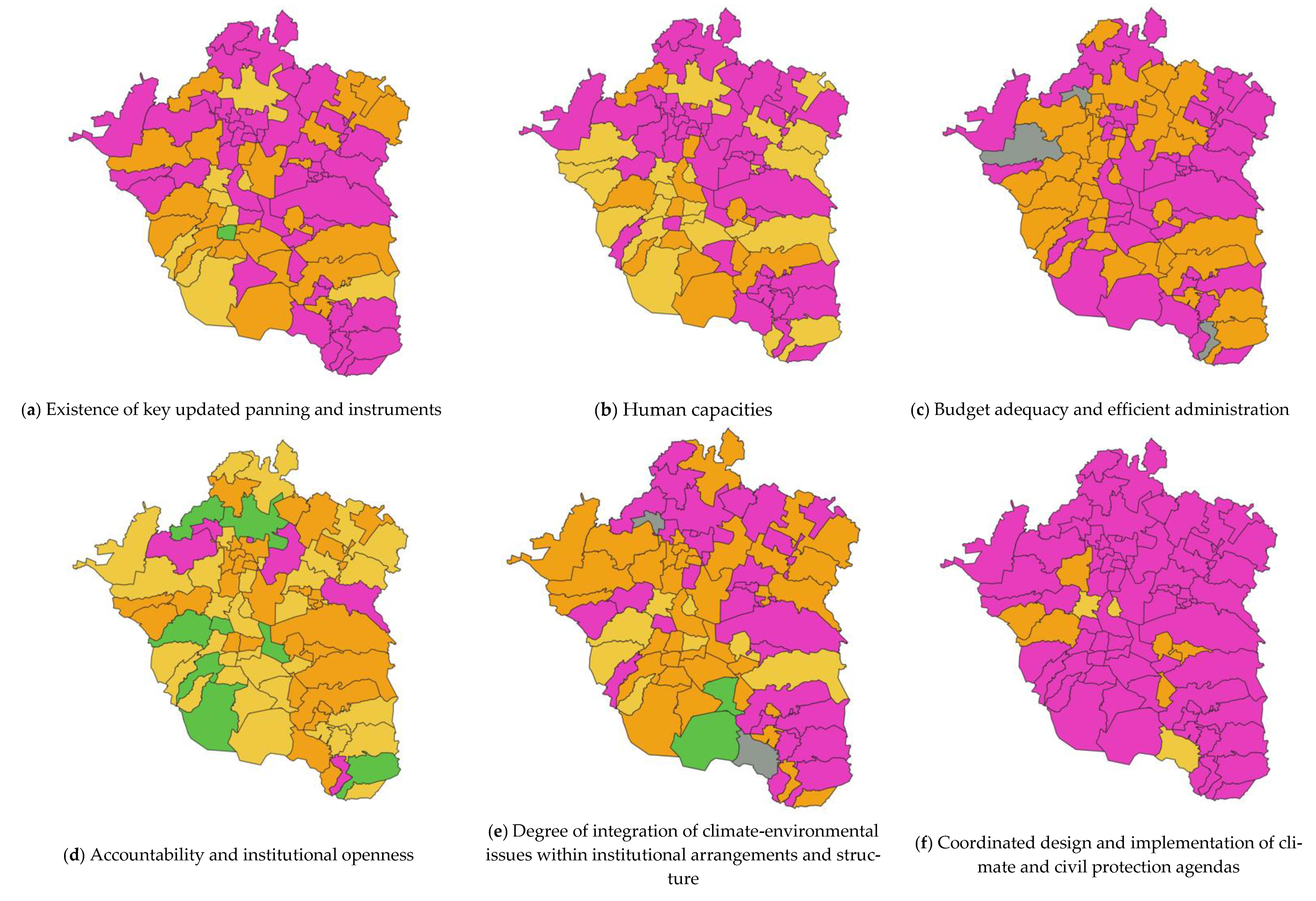
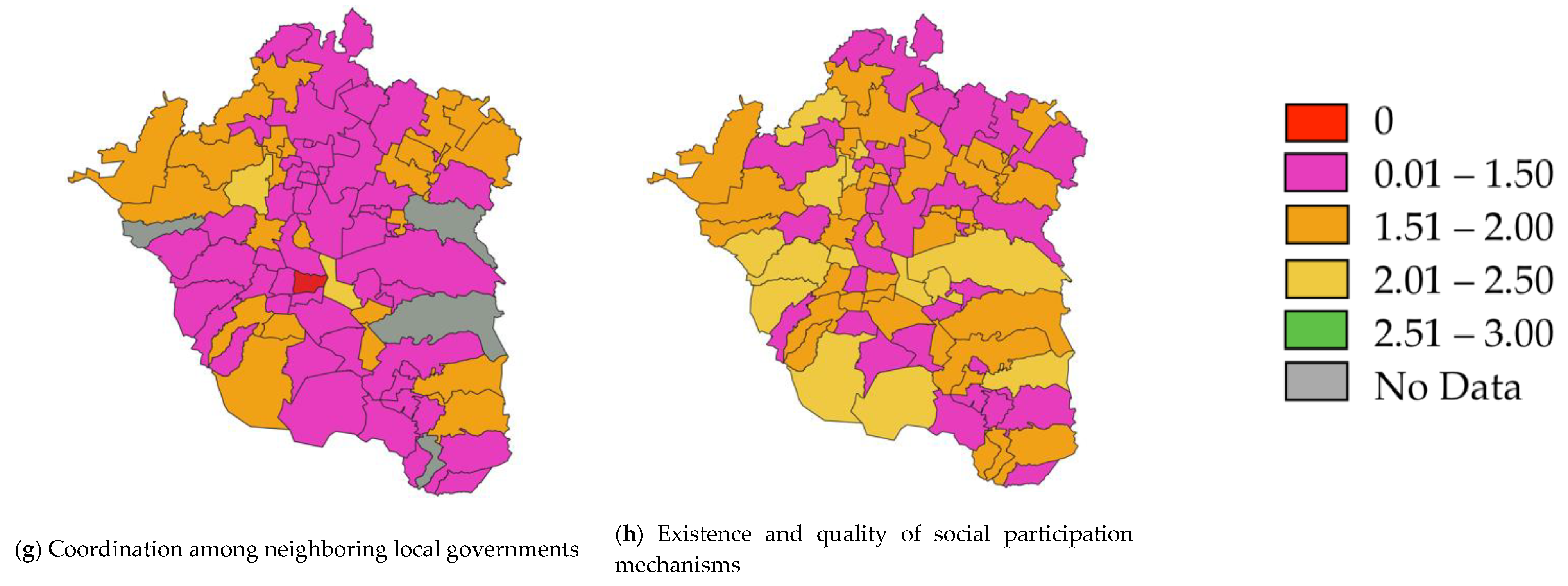
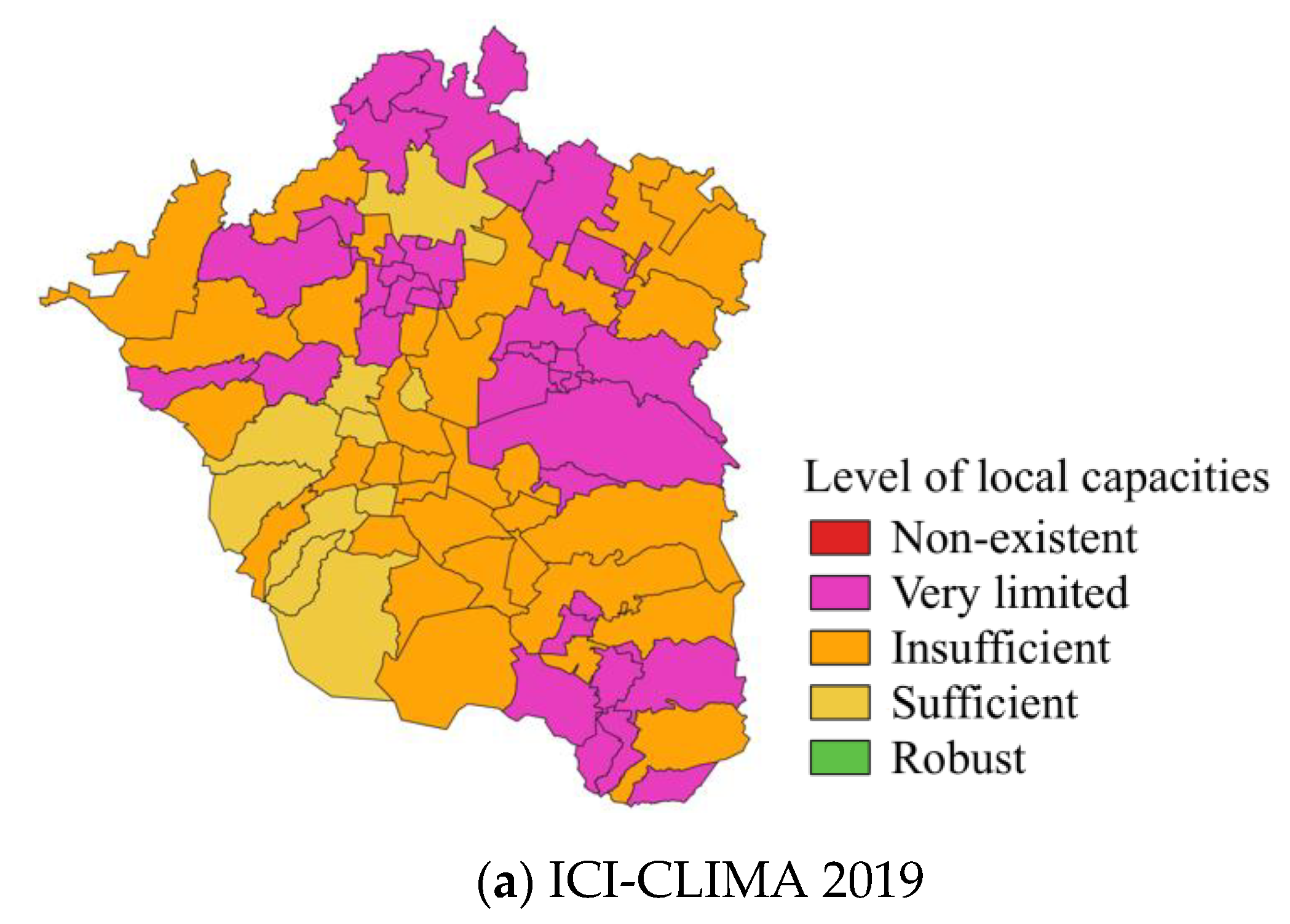
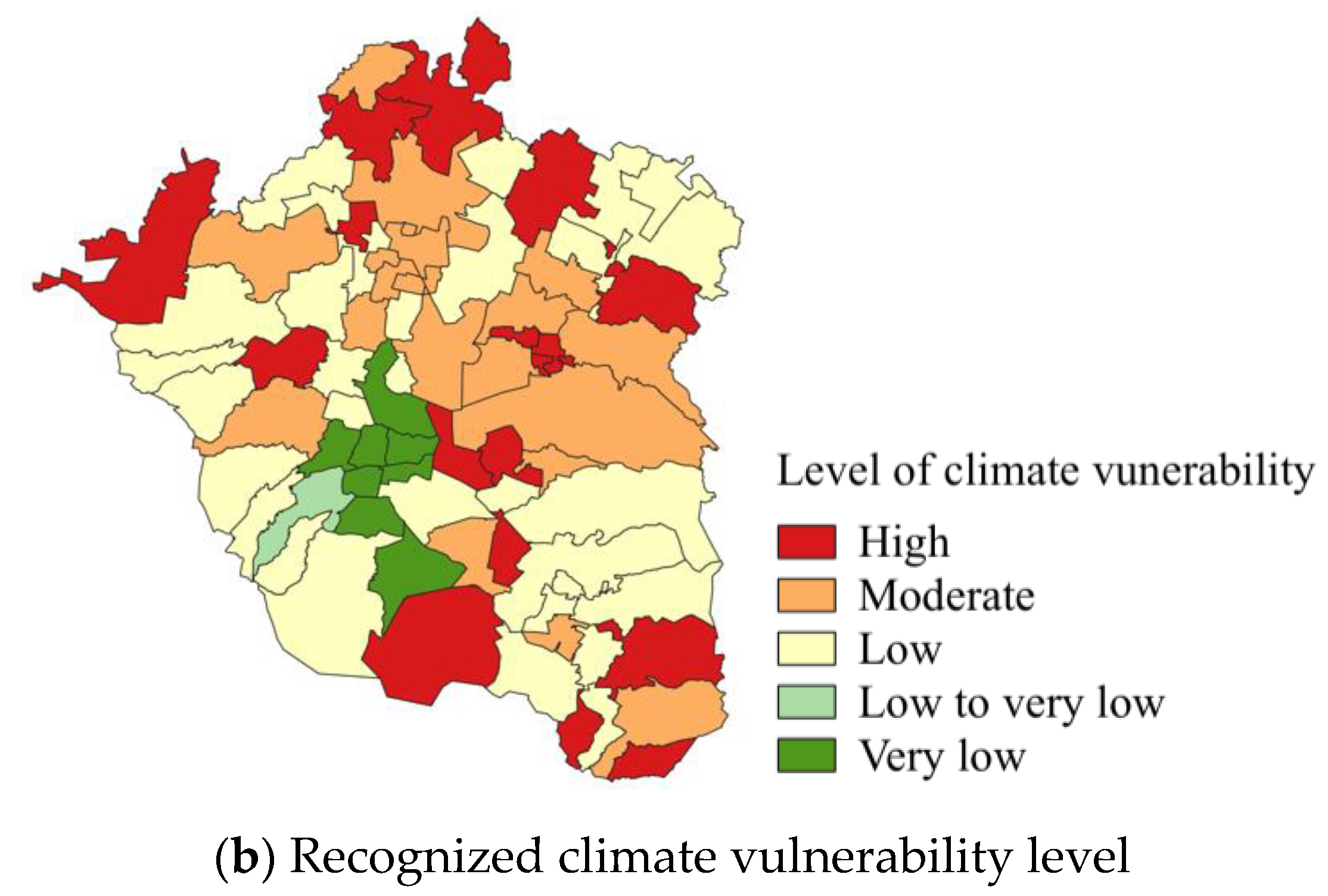
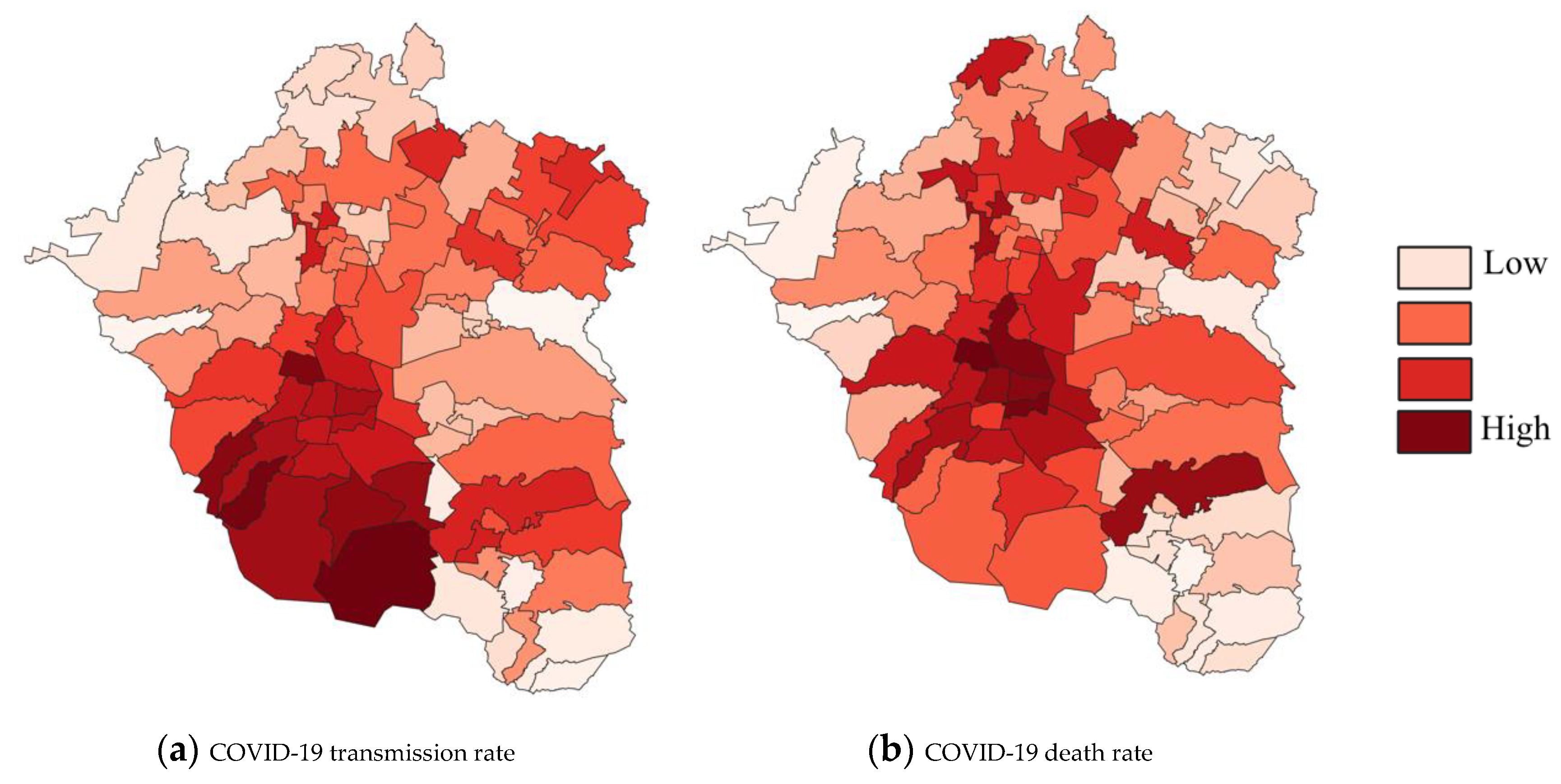
| Year | Water Footprint-WF (Billion Cubic Meters) | Waste (Million Tons) | GHG (Million Tons) | |||
|---|---|---|---|---|---|---|
| Agricultural WF | Industrial WF | Domestic WF | Total WF | |||
| 2015 | 202.8 | 6.7 | 11.6 | 221.1 | 46.9 | 441.4 |
| 2050 | 294.4 a | 9.8 a | 16.8 a | 321.0 a | 68.2 a | 640.9 a |
| 315.4 a,c | 18.4 a,b | 31.6 a,b | 365.4 a,b | 128.1 a,b | 1204.0 a,b | |
Publisher’s Note: MDPI stays neutral with regard to jurisdictional claims in published maps and institutional affiliations. |
© 2021 by the author. Licensee MDPI, Basel, Switzerland. This article is an open access article distributed under the terms and conditions of the Creative Commons Attribution (CC BY) license (http://creativecommons.org/licenses/by/4.0/).
Share and Cite
Delgado Ramos, G.C. Climate-Environmental Governance in the Mexico Valley Metropolitan Area: Assessing Local Institutional Capacities in the Face of Current and Future Urban Metabolic Dynamics. World 2021, 2, 32-48. https://doi.org/10.3390/world2010003
Delgado Ramos GC. Climate-Environmental Governance in the Mexico Valley Metropolitan Area: Assessing Local Institutional Capacities in the Face of Current and Future Urban Metabolic Dynamics. World. 2021; 2(1):32-48. https://doi.org/10.3390/world2010003
Chicago/Turabian StyleDelgado Ramos, Gian Carlo. 2021. "Climate-Environmental Governance in the Mexico Valley Metropolitan Area: Assessing Local Institutional Capacities in the Face of Current and Future Urban Metabolic Dynamics" World 2, no. 1: 32-48. https://doi.org/10.3390/world2010003
APA StyleDelgado Ramos, G. C. (2021). Climate-Environmental Governance in the Mexico Valley Metropolitan Area: Assessing Local Institutional Capacities in the Face of Current and Future Urban Metabolic Dynamics. World, 2(1), 32-48. https://doi.org/10.3390/world2010003





